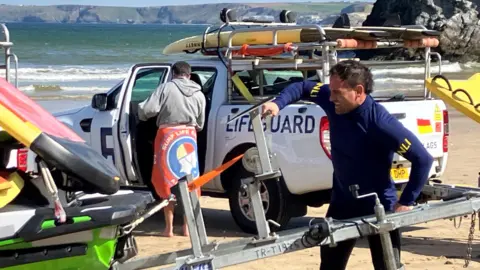Swimmers warned about rip currents after rescues
 Sam Chamberlain/RNLI
Sam Chamberlain/RNLILifeguards have warned beachgoers about the danger of rip currents after they rescued 10 swimmers from a sudden flash one at a Cornish beach.
The RNLI said the swimmers had been dragged out of their depth by flash rips at Perranporth beach on Saturday.
A flash rip is a fast-forming, powerful current which can appear suddenly, even in seemingly calm conditions.
The RNLI advised people to always swim between the yellow and red flags on a lifeguarded beach and, if caught by a rip current, to float on their back with their ears under the water.
 RNLI
RNLIJoel Ninnes, water safety delivery support for the RNLI, told BBC Radio Cornwall: "Rip currents can pop up at any state of the tide and people can get caught out fairly easily."
He said there had been several large incidents involving rip currents on Cornish beaches already this year at Perranporth and Trebarwith Strand.
Although lifeguards kept a watch for the rips, he said they could appear at any time due to the beach, size of swell and point in the tide.
"We've seen rip currents get up to 10, 11, 12 knots," he said. "They are incredibly strong and some can take you far out of the area."
If a confident swimmer became caught in a rip, Mr Ninnes said they should swim parallel to the shore to swim sideways out of the current towards waves which would help bring them in.
He advised people who were not strong swimmers that were caught in a rip to remember the RNLI's "float to live" message.
He said: "Relax, try and catch your breath then roll on to your back and do the starfish shape.
"Get your ears below the water line and move your arms and legs if you need to.
"If you can't get out of the rip current, raise your arm in the air and look for a lifeguard and let them know."
He said surfers and bodyboarders should hold on to their board and use it to help keep them afloat.

The best advice, Mr Ninnes said, was to look for rip currents before entering the water.
He said: "Rip current have a different texture on top of the water - choppy or churning - and a darker deeper shade of blue.
"Look for where the waves aren't breaking, look for the texture - smoothness on the water can highlight the rip current and look for that deeper, darker colour."
Follow BBC Cornwall on X, Facebook and Instagram. Send your story ideas to [email protected].
